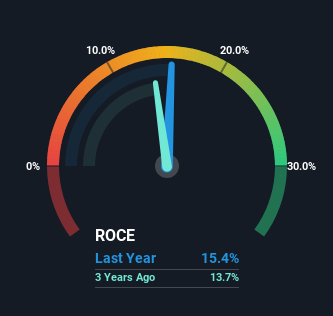Investors Met With Slowing Returns on Capital At Beiersdorf (ETR:BEI)
Finding a business that has the potential to grow substantially is not easy, but it is possible if we look at a few key financial metrics. Typically, we'll want to notice a trend of growing return on capital employed (ROCE) and alongside that, an expanding base of capital employed. If you see this, it typically means it's a company with a great business model and plenty of profitable reinvestment opportunities. With that in mind, the ROCE of Beiersdorf (ETR:BEI) looks decent, right now, so lets see what the trend of returns can tell us.
What Is Return On Capital Employed (ROCE)?
For those that aren't sure what ROCE is, it measures the amount of pre-tax profits a company can generate from the capital employed in its business. To calculate this metric for Beiersdorf, this is the formula:
Return on Capital Employed = Earnings Before Interest and Tax (EBIT) ÷ (Total Assets - Current Liabilities)
0.15 = €1.4b ÷ (€13b - €3.8b) (Based on the trailing twelve months to June 2023).
So, Beiersdorf has an ROCE of 15%. On its own, that's a standard return, however it's much better than the 9.4% generated by the Personal Products industry.
Check out our latest analysis for Beiersdorf
Above you can see how the current ROCE for Beiersdorf compares to its prior returns on capital, but there's only so much you can tell from the past. If you'd like, you can check out the forecasts from the analysts covering Beiersdorf here for free.
So How Is Beiersdorf's ROCE Trending?
While the returns on capital are good, they haven't moved much. The company has consistently earned 15% for the last five years, and the capital employed within the business has risen 45% in that time. 15% is a pretty standard return, and it provides some comfort knowing that Beiersdorf has consistently earned this amount. Stable returns in this ballpark can be unexciting, but if they can be maintained over the long run, they often provide nice rewards to shareholders.
In Conclusion...
The main thing to remember is that Beiersdorf has proven its ability to continually reinvest at respectable rates of return. In light of this, the stock has only gained 34% over the last five years for shareholders who have owned the stock in this period. So to determine if Beiersdorf is a multi-bagger going forward, we'd suggest digging deeper into the company's other fundamentals.
Beiersdorf could be trading at an attractive price in other respects, so you might find our free intrinsic value estimation on our platform quite valuable.
While Beiersdorf may not currently earn the highest returns, we've compiled a list of companies that currently earn more than 25% return on equity. Check out this free list here.
Have feedback on this article? Concerned about the content? Get in touch with us directly. Alternatively, email editorial-team (at) simplywallst.com.
This article by Simply Wall St is general in nature. We provide commentary based on historical data and analyst forecasts only using an unbiased methodology and our articles are not intended to be financial advice. It does not constitute a recommendation to buy or sell any stock, and does not take account of your objectives, or your financial situation. We aim to bring you long-term focused analysis driven by fundamental data. Note that our analysis may not factor in the latest price-sensitive company announcements or qualitative material. Simply Wall St has no position in any stocks mentioned.

